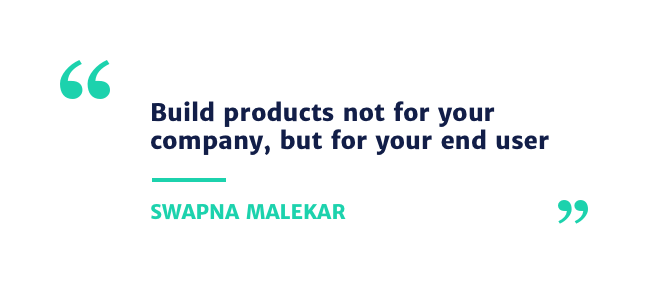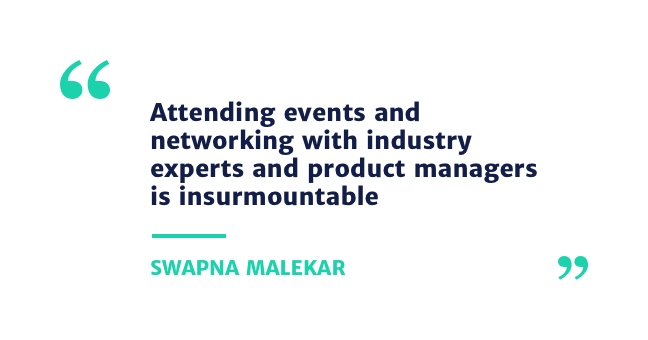Updated: January 24, 2024 - 10 min read
This week, Product School’s #AskMeAnything session welcomed RBC Senior Product Manager, Swapna Malekar!
Swapna is a Senior Product Manager at RBC, Canada’s leading bank, heading their innovation division to create products and digital solutions using lean methodologies. She is currently leading an initiative in the pension savings and retirement planning industry in Canada. Curious about how Product Managers have broken into and mastered their roles? Then join our Product Management Slack Community and ask them!

Prior to RBC, Swapna was the Head of Product at a UK-based SaaS Data intelligence company, Klood, that provided insights to enterprise clients through artificial intelligence. Whilst in Singapore, Swapna was responsible for driving the E-commerce growth for the Asian and European regions for the world’s largest publishing company, Scholastic, as their Product Manager. She started her career with Accenture and is a technology buff through and through. Her current passion is finding innovative use cases for blockchain and AI in the fintech/banking domain. You can follow her on Medium and Twitter!
Building Banking Products
As someone who builds products inside a bank, do you have any tips for people trying to build products for a bank? What are common pitfalls that you see others fall into? What are the biggest hurdles that you have to overcome?
One of the biggest hurdles we’ve run into is making sure our product is compliant in terms of risk and legality. Compliance plays a huge role in the banking system. Hence, we need to make sure we procure the requisite consent from the users before using their data, we are transparent about how we use this information, and so on.
An MVP for a bank is completely different than an MVP for a smaller/mid sized company. Even though banks are trying to be agile and nimble, we still need to build products that protect our client’s privacy right.
How much emphasis is placed on regulation/compliance? Is it a hindrance to your role as a Product Manager?
Yes, regulation and compliance are a large part of what I do on a day-to-day basis since I work in a bank and we’re creating financial products for our customers.
Since we are building banking products that represent a trusted organization, risk, legal and compliance play an important part and we have to build products that are transparent and explainable to the end users.
How do you manage the micro and macro parts of your work? Micro would mean resolving issues and seeing that all things are running smooth. Macro would mean building/improving the products tangibly.
For the micro parts of the work, I’ve learned to delegate since I frankly, I do have the luxury of having multiple resources in my team. It helps to empower them and guide them if required.
For the macro parts, I have to stay up to date with what’s happening within RBC and also outside (not just the banking industry but other sectors as well). For example, the rise of crypto technology would mean that we can start looking at other use cases in the banking world and provide a holistic end-to-end experience for our clients.

You stress the legal, risk, and compliance side of things a lot. As most products generate second and third-level use cases from the information they gather, what would you say are the best information sources for learning how we can use the data that our products generate to help firms achieve their compliance/legal obligations?
Reading helps – use cases from other companies – TechCrunch is a good source. What did these companies do and not do to make themselves legally compliant?
Again, there is no comparison to networking and attending events to learn and stay on top of what use cases you can solve for with the data you have.
For example, personalized content was initiated by the likes of Amazon, Netflix, and other retailers. However, building banking products can also provide personalized recommendations to clients.
How do you validate your opportunity hypothesis and your success metrics to decide if they are the right aspect of your product to measure success?
Talking to a lot of users to understand what job they’re trying to get done, what is their current behavior and how we can improve/solve their challenges.
Forming a hypothesis by brainstorming sessions with our internal partners (“design thinking”) – domain experts help a lot here.
Creating a preliminary wire-frame/mockups and guerrilla testing with a friendly group of users.
How do you overcome big bank legacy systems and old world thinking to innovate and move your products forward?
Involving your stakeholders along your journey (e.g. bringing business partners to some sprint sessions) helps them understand how the new agile processes work, and how can they benefit from adopting them.
And it’s a constant selling – as a product manager, you need to sell your vision, your brand, your products not just to users, but more importantly, to stakeholders within your company to get their buy-in.
Compared to other domains, such as consumer internet/e-commerce, is the fintech space significantly more challenging for early-stage startups than for large organizations given the aspects of risk, regulations, and compliance? Do you foresee any trends or niche areas in the whole finance domain that potential startups can tap into?
There are likes of CoinSquare.io that are investing in risk, legal, and compliance right from the start because crypto is becoming a regulated industry. The main challenge that I see fintech startups facing is the early adoption curve and trust from users. It’s easier to believe in a bank because their brand is already established and it’s easy to get traction for a big banking digital app from day 1 (just because of the user base it already caters to).
As far as trends go, blockchain-based use cases are what startups are currently focusing on. Some other trends are end-to-end solutions (e.g. thinking of a fintech product as your CFO rather than just an app). Hence there are products out there that track spending, save on your behalf, provide you with financial and life recommendations and also invest for you (robo-advisor).

How do you handle the need for documentation in RBC in terms of BRDs FSDs in this dynamic environment? I am assuming your Product uses Agile. Is there a middle ground your team has adapted?
We use user stories (agile/scrum) within our team since we work directly with engineers and designers to implement and launch a product.
In some cases where external vendors are involved, we still create user stories and go with our biweekly sprint cycle. However, if they require any documentation from us, we provide them in a document format (either on Confluence or WordDocs). We also ask them to meet us face to face so that they know how the agile works and why we don’t work with BRDs.
Staying Updated with Current Trends
Where do you find the best information on emerging trends, in other words, where is the best place to spend time? Do you absorb it across a variety of media or do you find some sources that are consistently stronger in identifying trends on the front end?
Yes, there are so many product leaders out there. Following your favorite ones on Twitter or reading their blogs definitely helps. However, on a day to day basis, reading TechCrunch, HackerNews, and Medium are great as well.
Also, attending events. I aim to attend 3-4 product management events per week to network and to learn.
How do you keep yourself up-to-date on the latest in tech? What would you recommend as good a good source of knowledge?
I attend a lot of events – not just product-related, but also domain-specific such as finance, insurance, even automotive and manufacturing sometimes.
The level of information you can assimilate by attending events and networking with industry experts and product managers is insurmountable.
As for keeping up-to-date on what’s happening outside in AI and fintech, TechCrunch is my go-to resource. Same with Medium, HackerNews, etc.
Breaking Into Product Management
What advice would you give to a college student interested in Product Management? How can I supplement my regular courses to prepare for a PM internship/position?
I’m a big believer in working at startups. I’ve learned the vast majority of my product lessons working for my previous company, where I had to wear multiple hats and think about the product, and not just UX, data mapping, and development.
If you could do an internship or work as a PM in a startup, that’s the best learning experience you could ever get for a product management role.

If you could go back to your first job as PM, what do you wish you knew that you picked up a bit later on in your career?
As a first-time product manager, I used to be super careful and meticulous around dates and processes. However, I realized processes are as good as we make them to be. If a process is set and being followed; however, it is not as effective as it was previously, product teams should be flexible enough to change it for the better.
I want to move to product management from an iOS app developer role. How can I make this switch?
Start reading about product management and see if you like this role. Maybe shadow a product manager in your company to see what the day-to-day looks like.
If you’re ready to jump in:
Start reading about product management (tons of stuff out there).
Attend product events in your city.
Start side projects (either within your company or outside) that would provide you with a flavor of what it is like to be a product person.
I’m working on a video/audio product. We could be more focused on music, certain types of music, more toward interviewing, live streaming, more audio features vs. more video features, target novice-easy vs. advanced-powerful use cases, etc. How would you go about vetting these opportunities and doing market sizing?
I would first see what the long-term vision of your company is. Do you guys want to be focussed on audio or video, for what kinds of audience and so on.
This vision would help you navigate which opportunities are worth looking into. Basically, you need to decide what is the right problem to solve when you have 10 opportunities in front of you.
Look at the trends. Sometimes trends from other industries/domains can affect your products/domain. For example, the rise of mining cryptocurrencies directly affected the CPU and hardware industry (in a positive way).
Look at the kind of audience it caters to, long terms opportunities vs. short-term wonders, collaboration opportunities, etc.
I can write a lot on this topic. Good question!
Any final advice for aspiring Product Managers?
For aspiring product managers, be fearless and get out there – work in a startup, start a side-project, shadow a PM, take a course, attend events, network – there are endless opportunities out there.
And when you do become an experienced PM, remember to empower your teams, take risks, challenge yourself and build products not for your company, but for the end users.
Updated: January 24, 2024